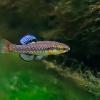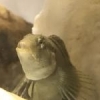Being a brackish water fish, this is probably not a fish that a lot of people have kept. So lack of experience probably explains why no answers yet.
I have kept a few ... that literally washed into my front yard during Hurricane Hermine ... in a pure f/w community tank. And I've kept them before in brackish water tanks. I have not tried keeping them outdoors. Some observations:
* seem to do fine in a pure f/w environment with plants. I had four originally, lost one in Dec and another last month. AFAICT, just normal age-related mortality, they were all adult-sized when I got them in August.
* they're reasonably active fish
* omnivores, happy to take a variety of flake foods
* bottom-dwellers, and semi-cryptically colored from above.
* Breeding males get an irridiscent blue flash on their head which is attractive.
* They also tend to get rather territorial, and expend much energy defending their territory. Certainly from other male CVs, but also from some other species. Or individuals they don't like. I haven't figured out exactly what gets their attention. Having various pieces of structure reduces the visual stimulation and gives cover to the pursued. I have not seen physical damage, it's mostly chasing. They don't tend to go up and bother mid-water or top-water fish. (one batch of brackish water ones were in a 55g, mostly with other brackish water killies, like F. grandis and similis, and mollies; the others were in a 20L species tank.)
The fact that they seem to live well in freshwater is a big plus, since there's very few aquarium-type plants that like salt. Don't know if they would breed in f/w however.
I count these pupfish as "personality fish" with an interesting shape and behaviors. You'd miss out on a lot of that by putting them in a container pond, as opposed to an aquarium where you could more easily watch them,
In the wild, adults and especially juvvies are often seen in extremely shallow water, usually over sand.
Cohabitate especially well with mollies, which tend to prefer the surface and mid-waters.
Don't have personal experience with their cold water adaptations.
A 24" pot filled with water is going to be heavy enough that an inch or two of substrate isn't going to make a significant difference in how movable the pot is. I think a substrate will make a significant difference in how comfortable your CV are in their environment. But you can get a serious wheeled plant stand (dolly) for $20 to $30 that would give your pot mobility. (On a smooth surface, not so much on grass.) I've had good luck with the DeVault brand (see Amazon) but there are others that look comparable.
HTH - YMMV
![]() Really confuses me why sheepsheads aren't more popular aquarium fishes considering how hardy they are.
Really confuses me why sheepsheads aren't more popular aquarium fishes considering how hardy they are.









